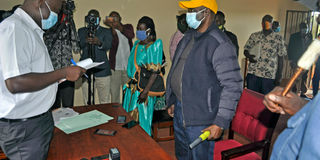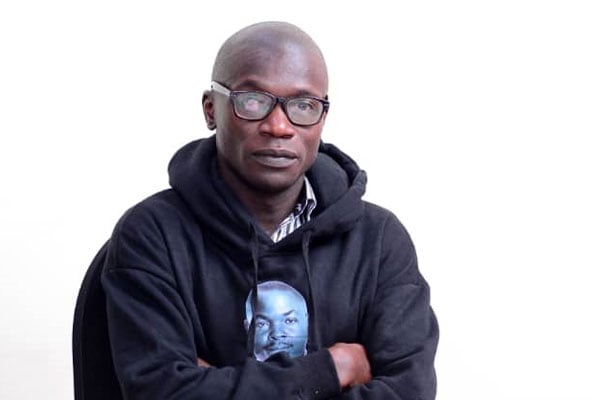Prime
Can the Opposition mount strong challenge in Omoro?

Omoro District Electoral Commission registrar Denis Obong (left) confirms former Speaker of Parliament Jacob Oulanyah (right) as winner of Omoro County MP seat in January 2021. PHOTO/ FILE.
What you need to know:
The Omoro County by-election slated for May 26 following the death of the incumbent Jacob Oulanyah, presents a chance to indicate whether there has or has not been an Opposition renaissance after NRM’s massive win in the sub-region in the 2021 polls.
The forthcoming Omoro County by-election is being touted as a referendum that will indicate if the Opposition has managed to breach President Museveni’s political bastion in the north.
Under the stewardship of Dr Kizza Besigye, the Opposition had made sub-regions such as Acholi a stronghold.
Results released by the Electoral Commission (EC) indicate that the sub-region, however, overwhelmingly endorsed President Museveni and his National Resistance Movement (NRM) party during the 2021 General Election.
The Omoro County by-election, which is slated to take place on May 26 following the death of the incumbent Jacob Oulanyah, presents a chance to indicate whether there has or has not been an Opposition renaissance.
The NRM is unsurprisingly upbeat if anything because Oulanyah—who represented the constituency for 16 years—had not only sealed the Speakership at the time of his death but also was the party’s vice chairperson in northern Uganda.
While the ruling party has a structure already put in place, not all is well in its ranks. Question marks hovering over what claimed Oulanyah’s death at the tender age of 56 are sowing seeds of doubts in the minds of Omoro County constituents.
Oulanyah’s father—Nathan Okori—opened the can of worms on March 20 when he expressly stated that his son was poisoned.
Mr Okori doubled down the claims at his son’s burial on April 8.
A post-mortem report read by Health minister Jane Ruth Aceng, however, indicates that Oulanyah lost a two-year battle to cancer (lymphoma).
“The report I have here is the death summary report for the late Rt Hon Jacob Oulanyah L’Okori and they are four. One, the immediate cause of death was multiple organ failure—the heart failed, the lung failed, the liver failed and the kidney failed. The liver started failing while he was still here in Uganda, as well as the lungs that had started collecting fluid,” Ms Aceng told Parliament.
She added: “The heart started failing while in Seattle [US, where Oulanyah had been medevacked for specialised treatment] as well as the kidney. He had multiple bacterial infections, the viral infection that was discovered in Seattle.”
Impact of poison claims
The poison narrative was, however, also perpetuated by the Acholi paramount chief—Rwot David Acana II—and Acholi Parliamentary Group (APG), both of whom questioned not only Oulanyah’s death but that of other luminaries, including former deputy Inspector General of Police Paul Lokech and Maj Gen Julius Oketta.
After Oulanyah’s passing, Rwot Acana II asked rhetorically: “Is poisoning now an open method of elimination in Uganda? Who is behind it? Is it an individual or an organised entity?”
While the police has since summoned both Mr Okori and Rwot Acana II over the comments, there is a belief that the poison narrative could work to the detriment of the NRM.
Already, the Opposition has seized upon it. The Forum for Democratic Change (FDC) president, Mr Patrick Oboi Amuriat, recently wrote on Twitter: “The NRM government must answer the unanswered questions. FDC demands an investigation.”
He also added that Oulanyah’s death “could be a game-changer.”
The leading Opposition party National Unity Platform (NUP) has also been vocal.
It also rubbed government functionaries the wrong way by appearing to protest Oulanyah’s medevac to Seattle.
“You need to apologise to the Acholi. You need to apologise to the people of Omoro. Otherwise, that demonstration was uncalled for because when somebody falls sick, you don’t demonstrate: Assuming it was your father? Assuming it was your brother, would you demonstrate that the government is spending Shs1.7b to take him to Seattle for treatment?” Fr Charles Onen, the Gulu East MP, said last Sunday during a church service in Gulu City.
Fr Onen warned that once NUP fails to issue an apology, “it will be difficult for [them] to be accepted in northern Uganda.”
NUP—which is chiefly dominated by Baganda legislators—has struggled to get a foothold in many parts of Uganda, Acholi Sub-region inclusive. Their leadership also appeared to be called out by Chief Justice Alfonse Owiny-Dollo, who reasoned that protests around Oulanyah’s medevac were in bad taste.
NUP backlash?
While at the burial of singer Mathias Walukagga’s father last month, NUP president Robert Kyagulanyi, alias Bobi Wine, made Oulanyah’s death the centrepiece of his speech. He condemned the government for “wasting” taxpayer’s money on treating Oulanyah abroad.
“While we are burying our friend’s father, [the] Speaker’s body is still detained in the hospital [in Seattle],” Bobi Wine said, adding: “They put him on the plane and they used Shs1.5b. They used Shs1.5b! Just to transport him to the hospital. Where they took him—the doctors and the Minister of Health [Ms Aceng] informed us they didn’t touch him. They didn’t treat him at all.”
Although all government officials who went to visit Oulanyah have confirmed that they found him alive, Bobi Wine seemed to have doubts.
“Did they take him when he was alive or not?” he rhetorically asked. “That will be answered later.”
If there were doubts about the perilous situation in which NUP finds itself, all was made clear when Mr Kyagulanyi attempted to extend an olive branch to Oulanyah’s family.
Although the Opposition was given a chance to lay a wreath on Oulanyah’s casket during his burial, Mr Kyagulanyi—who was a no-show then—met a more unenthusiastic audience when he visited Mr Okori on April 10.
Mr Kyagulanyi made a blunder when he included shadow cabinet minister Gilbert Olanya (Kilak South, FDC) in his entourage.
Mr Olanya is on record for having bitterly opposed Oulanyah’s eventually successful attempt to take the Speakership out of Rebecca Kadaga’s grasp.
“What is Olanya doing here?” Mr Okori could be heard asking Mr Kyagulanyi in a video recording of the visit that went viral.
Not even the presence of renowned diplomat Olara Otunnu thawed out things, with the goat that Bobi Wine went with reportedly rejected.
NUP spokesperson Joel Ssenyonyi was, however, quick to dismiss that account of events as “propaganda by the media.”
Mr Ssenyonyi (Nakawa West) couldn’t, however, confirm if the party will present a candidate in the Omoro by-election, saying a communication on the same will come in “very soon.”
There could, of course, be the option of the Opposition fielding a joint candidate. In Acholi Sub-region, the FDC fared better than other Opposition parties during last year’s elections. The Najjanankumbi-based party scooped six seats.
Elsewhere, the Democratic Party (DP) helped itself to three seats. The FDC is expected to present a candidate in the by-election with three party members—Simon Tolit, who defeated Oulanyah in 2006; Terece Odonga, who was trounced by Oulanyah in 2021; and Dick Owani—in the frame.
“We mourned with the people of Omoro and the party participated in burial arrangements. The party is also going to participate in this electoral process because Omoro used to be an Opposition area and we know it very well,” Mr Hassan Kaps Fungaroo, the officer-in-charge of mobilisation at FDC, told Saturday Monitor.
Work cut out
Observers, nevertheless, say while the FDC has structures in Acholi Sub-region, it is a shadow of the party that polled well there during the 2006 General Election. FDC Acholi kingmakers such as Reagan Okumu were ousted from Parliament where he represented Aswa County for three terms.
Other key party stalwarts from the sub-region such as Samuel Odonga Otto (Aruu South) and Prof Morris Ogenga-Latigo (Ogago North) decamped before they lost their seats to NRM-leaning candidates.
Both FDC’s weaning powers and NRM’s emergency as a force in Acholi Sub-region can be attributed to the end of the Lord Resistance Army (LRA) insurgence. After the guns went silent in 2006 and the NRM government moved to rehabilitate the north (with projects such as the Northern Uganda Social Action Fund or Nusaf), the Opposition has found the going really hard.
Nusaf aims at furthering the development of districts that were predominantly atrophied by war and cattle-rustling. It sets out to fight poverty using four approaches—building community infrastructures, such as roads, schools, health centres, and water sources; funding income-generating activities for vulnerable groups; promoting community reconciliation and conflict management and supporting institutional development.
READ MORE





